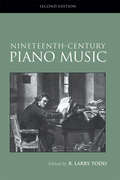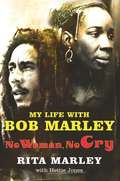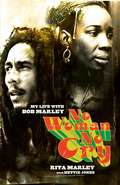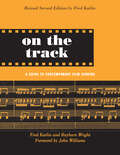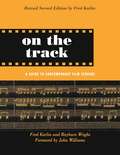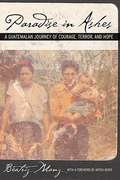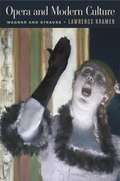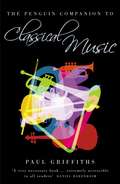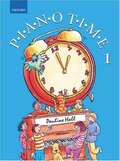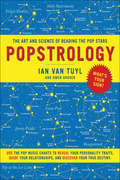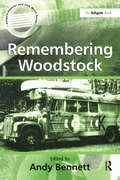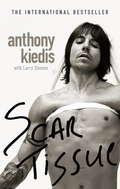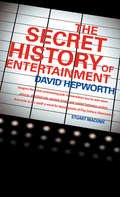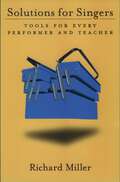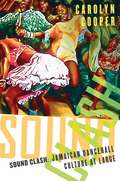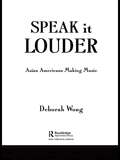- Table View
- List View
Nineteenth-Century Piano Music
by R. Larry ToddFirst Published in 2004. Routledge is an imprint of Taylor & Francis, an informa company.
Nineteenth-Century Piano Music
by R. Larry ToddFirst Published in 2004. Routledge is an imprint of Taylor & Francis, an informa company.
No Woman No Cry: My Life With Bob Marley
by Rita Marley Hettie JonesBob Marley is the unchallenged king of reggae and one of music's great iconic figures. Rita Marley was not just his wife and the mother of four of his children but his backing singer and friend, life-long companion and soul mate. They met in Trenchtown when he was 19 and she was 18, and she was very much part of his musical career, selling his early recordings from their house in the days before Island Records signed up the Wailers. She shared the hard times and the dangers - when Bob was wounded in a gunfight before the Peace Concert, Rita was shot in the head and left for dead. Their marriage was not always easy, but Rita was the woman Bob returned to no matter where music and other women might take him, the woman who held him when he died at the age of 35. Today she sees herself as the guardian of his legacy. Full of new insights, No Woman No Cry is a unique biography of Marley by someone who understands what it meant to grow up in poverty in Jamaica, to battle racism and prejudice. It is also a moving and inspiring story of a marriage that survived both poverty and then the strains of global celebrity. 'It will surely become the definitive biographical account of the reggae guitarist-singer-songwriter who changed pop music and in the process became a leader to millions' The Times 'Rita Marley is reggae royalty . . . In her own words, this is a revealing insight into Marley's life and legacy' Daily Mirror
No Woman No Cry: My Life with Bob Marley
by Rita MarleyA memoir by the woman who knew Bob Marley best--his wife, Rita. Rita Marley grew up in the slums of Trench Town, Jamaica. Abandoned by her mother at a very young age, she was raised by her aunt. Music ran in Rita's family, and even as a child her talent for singing was pronounced. By the age of 18, Rita was an unwed mother, and it was then that she met Bob Marley at a recording studio in Trench Town. Bob and Rita became close friends, fell in love, and soon, she and her girlfriends were singing backup for the Wailers. At the ages of 21 and 19, Bob and Rita were married. The rest is history: Bob Marley and the Wailers set Jamaica and the world on fire. But while Rita displayed blazing courage, joy, and an indisputable devotion to her husband, life with Bob was not easy. There were his liaisons with other women--some of which produced children and were conducted under Rita's roof. The press repeatedly reported that Bob was unmarried to preserve his "image." But Rita kept her self-respect, and when Bob succumbed to cancer in 1981, she was at his side. In the years that followed, she became a force in her own right -- as the Bob Marley Foundation's spokesperson and a performer in her reggae group, the I-Three. Written with author Hettie Jones, No Woman No Cry is a no-holds-barred account of life with one of the most famous musicians of all time. In No Woman No Cry, readers will learn about the never-before-told details of Bob Marley's life, including: How Rita practiced subsistence farming when first married to Bob to have food for her family. How Rita rode her bicycle into town with copies of Bob's latest songs to sell. How Rita worked as a housekeeper in Delaware to help support her family when her children were young. Why Rita chose to befriend some of the women with whom Bob had affairs and to give them advice on rearing the children they had with Bob. The story of the attack on Bob which almost killed the two of them. Bob's last wishes, dreams, and hopes, as well as the details of his death, such as who came to the funeral (and who didn't).
On the Track: A Guide to Contemporary Film Scoring
by Fred Karlin Rayburn WrightOn the Track offers a comprehensive guide to scoring for film and television. Covering all styles and genres, the authors, both noted film composers, cover everything from the nuts-and-bolts of timing, cuing, and recording through balancing the composer's aesthetic vision with the needs of the film itself. Unlike other books that are aimed at the person "dreaming" of a career, this is truly a guide that can be used by everyone from students to technically sophisticated professionals. It contains over 100 interviews with noted composers, illustrating the many technical points made through the text.
On the Track: A Guide to Contemporary Film Scoring
by Fred Karlin Rayburn WrightOn the Track offers a comprehensive guide to scoring for film and television. Covering all styles and genres, the authors, both noted film composers, cover everything from the nuts-and-bolts of timing, cuing, and recording through balancing the composer's aesthetic vision with the needs of the film itself. Unlike other books that are aimed at the person "dreaming" of a career, this is truly a guide that can be used by everyone from students to technically sophisticated professionals. It contains over 100 interviews with noted composers, illustrating the many technical points made through the text.
Opera And Modern Culture: Wagner And Strauss (PDF)
by Lawrence KramerMusicologist Lawrence Kramer argues that for the past two centuries the preoccupation of a group of famous operas with the limits of supremacy & debasement has come to define a normality that is the very opposite of the operatic.
Opera and Modern Culture: Wagner and Strauss (PDF)
by Lawrence KramerIn this enlightening and entertaining book, one of the most original and sophisticated musicologists writing today turns his attention to music's most dramatic genre. Extending his ongoing project of clarifying music's various roles in Western society, Kramer brings to opera his distinctive and pioneering blend of historical concreteness and theoretical awareness. Opera is legendary for going to extremes, a tendency that has earned it a reputation for unreality. Opera and Modern Culture shows the reverse to be true. Kramer argues that for the past two centuries the preoccupation of a group of famous operas with the limits of supremacy and debasement helped to define a normality that seems the very opposite of the operatic. Exemplified in a series of beloved examples, a certain idea of opera—a fiction of opera—has contributed in key ways to the modern era's characterizations of desire, identity, and social order. Opera and Modern Culture exposes this process at work in operas by Richard Wagner, who put modernity on the agenda in ways no one after him could ignore, and by the young Richard Strauss. The book continues the initiative of much recent writing in treating opera as a multimedia rather than a primarily musical form. From Lohengrin and The Ring of the Niebelung to Salome and Elektra, it traces the rich interplay of operatic visions and voices and their contexts in the birth pangs of modern life.
The Penguin Companion to Classical Music
by Paul GriffithsThis superbly authoratitive new work provides a comprehensive A-Z guide to some 1000 years of Western music. It explores in detail the lives and achievements of a vast range of composers, as well as looking at such key topics as music history (from medieval plainchant to contemporary minimalism), performers, theory and jargon. Throught Griffiths skilfully blends lightly worn scholarship with personal insight, whether examining the emotional colouring that different musical keys achieve or charting the rise and development of the symphony.
Piano Time 1: (pdf)
by Pauline HallPiano Time 1 starts at the very beginning, with simple five-finger tunes for hands separately and together, many with duet parts. It gradually adds more notes and techniques to cover sharps and flats, simple scales and keys, and a range of dynamics and symbols.
The Political Art of Bob Dylan
by David Boucher Gary BrowningDavid Boucher and Gary Browning provide a multi-faceted analysis of the political art of Bob Dylan. The contributions cover Dylan's career as a whole, dealing with such themes as alienation, protest, non-conformity and the American Dream. Dylan's work is examined from a variety of perspectives including the aesthetic theory of Kant, Adorno, Lyotard and Collingwood. The assembled authors are notable specialists in political theory, literary criticism and popular culture. They do not tackle Dylan from a single standpoint but collectively question how Dylan's work relates to the theory and practice of politics.
Popstrology: The Art and Science of Popstars
by Ian Van TuylWhich force was more likely to have penetrated your essence and shaped your destiny if you were born in February of 1964: the orbital shufflings of Mars and Jupiter, or the explosive rise of the stars called the Beatles? By linking your personality and potential to the star who ruled the pop universe at the moment of your birth, Popstrology offers an entirely new approach to illuminating your spirit and your soul. Could the roots of your chronic restlessness lie in the fact that you are a Commodore born in the Year of Debby Boone? Could your crippling sexual inhibition result from being a Pat Boone born in the Year of Elvis Presley? Yes, they could. Could Britney Spears have been born under the influence of anything other than Olivia Newton-John's "Physical"? No, she couldn't. Fresh, funny and remarkably persuasive, this groundbreaking book reveals the powers hidden in a galaxy of stars we all can name, and in so doing gives us the right sign for modern times. Ian Van Tuyl is a Double Monkee and the author of the original Princeton Review Guide to the Best U.S. Law Schools.
Professional Music-Making in London: Ethnography and Experience (SOAS Studies in Music)
by Stephen CottrellProfessional Music-Making in London is an engaging yet innovative study which examines the lives and work of Western art musicians from an ethnographic perspective. Drawing in part on his own professional experience, Stephen Cottrell considers to what extent musicians in Western society conform to Alan Merriam's paradigmatic assessment of them as having low status yet high respect, as well as being given an unusual degree of licence to deviate from convention. The book draws on a wide variety of approaches from scholars elsewhere: from ethnomusicologists such as Bruno Nettl and Henry Kingsbury, performance theorists such as Richard Schechner and Victor Turner, as well as psychologists such as Sigmund Freud and Melanie Klein. This rich intellectual heritage provides the framework for discussion of a variety of themes, including how musicians conceive their self identity and how this is negotiated in the professional musical world; how the deputy system facilitates musical exchange and engenders gift relationships; how humour lubricates social and musical relationships and mitigates the stresses of musicians' lives; and how the events in which musicians participate can be viewed as quasi-rituals, and thus related to analogous events in non-Western cultures. The focus of this study is on professional music-making in London, one of the world's busiest centres of musical performance. Yet the issues raised and explored are deeply relevant to other major centres of Western art music, such as New York, Berlin or Sydney. Ethnomusicologists, anthropologists, musicologists, performers, teachers and concert-goers will find this book a stimulating insight into, and investigation of, Western art musicians and their place in today's world.
Professional Music-Making in London: Ethnography and Experience (SOAS Studies in Music)
by Stephen CottrellProfessional Music-Making in London is an engaging yet innovative study which examines the lives and work of Western art musicians from an ethnographic perspective. Drawing in part on his own professional experience, Stephen Cottrell considers to what extent musicians in Western society conform to Alan Merriam's paradigmatic assessment of them as having low status yet high respect, as well as being given an unusual degree of licence to deviate from convention. The book draws on a wide variety of approaches from scholars elsewhere: from ethnomusicologists such as Bruno Nettl and Henry Kingsbury, performance theorists such as Richard Schechner and Victor Turner, as well as psychologists such as Sigmund Freud and Melanie Klein. This rich intellectual heritage provides the framework for discussion of a variety of themes, including how musicians conceive their self identity and how this is negotiated in the professional musical world; how the deputy system facilitates musical exchange and engenders gift relationships; how humour lubricates social and musical relationships and mitigates the stresses of musicians' lives; and how the events in which musicians participate can be viewed as quasi-rituals, and thus related to analogous events in non-Western cultures. The focus of this study is on professional music-making in London, one of the world's busiest centres of musical performance. Yet the issues raised and explored are deeply relevant to other major centres of Western art music, such as New York, Berlin or Sydney. Ethnomusicologists, anthropologists, musicologists, performers, teachers and concert-goers will find this book a stimulating insight into, and investigation of, Western art musicians and their place in today's world.
Puccini and The Girl: History and Reception of The Girl of the Golden West
by Rosalind Gray Davis Annie J. RandallSet in the American West during the California Gold Rush, La fanciulla del West marked a significant departure from Giacomo Puccini's previous and best- known works. Puccini and the Girl is the first book to explore this important but often misunderstood opera that became the earliest work by a major European composer to receive an American premiere when it opened at New York's Metropolitan Opera House in 1910. Adapted from American playwright David Belasco's Broadway production, The Girl of the Golden West, Fanciulla was Puccini's most consciously modern work, and its Met debut received mixed reviews. Annie J. Randall and Rosalind Gray Davis base their account of its creation on previously unknown letters from Puccini to his main librettist, Carlo Zangarini. They mine musical materials, newspaper accounts, and rare photographs and illustrations to tell the full story of this controversial opera. Puccini and the Girl considers the production and reception of Puccini's "cowboy" opera in the light of contemporary criticism, providing both fascinating insight into its history and a look to the future as its centenary approaches. “Engrossing. . . . An eminently readable, ideally direct and information-packed book.”—William Fregosi, Opera Today
Remembering Woodstock (Ashgate Popular and Folk Music Series)
by Andy BennettThe Woodstock festival of 1969, which featured such groups and artists as the Who, Country Joe and the Fish, Ten Years After, Janis Joplin and Jimi Hendrix, is remembered as much for its 'bringing together' of the counter-cultural generation as for the music performed. The event represented a milestone in the use of music as a medium for political expression while simultaneously acting as a springboard for the more expressly commercial of rock and pop events which were to follow. In the thirty years since the festival took place, Woodstock has become the subject of many books, magazine articles and documentaries which have served to mythologise the event in the public imagination. These different aspects of the Woodstock festival will be discussed in this wide ranging book which brings together a number of established and new writers in the fields of sociology, media studies and popular music studies. Each of the five chapters which will focus on a specific aspect of the Woodstock festival and its continuing significance in relation to the music industry, the rock festival 'tradition', sixties nostalgia and the cultural impact of popular music.
Remembering Woodstock (Ashgate Popular and Folk Music Series)
by Andy BennettThe Woodstock festival of 1969, which featured such groups and artists as the Who, Country Joe and the Fish, Ten Years After, Janis Joplin and Jimi Hendrix, is remembered as much for its 'bringing together' of the counter-cultural generation as for the music performed. The event represented a milestone in the use of music as a medium for political expression while simultaneously acting as a springboard for the more expressly commercial of rock and pop events which were to follow. In the thirty years since the festival took place, Woodstock has become the subject of many books, magazine articles and documentaries which have served to mythologise the event in the public imagination. These different aspects of the Woodstock festival will be discussed in this wide ranging book which brings together a number of established and new writers in the fields of sociology, media studies and popular music studies. Each of the five chapters which will focus on a specific aspect of the Woodstock festival and its continuing significance in relation to the music industry, the rock festival 'tradition', sixties nostalgia and the cultural impact of popular music.
Scar Tissue: Der Sänger Der Red Hot Chili Peppers - Die Autobiographie
by Anthony KiedisIn SCAR TISSUE Anthony Kiedis, charismatic and highly articulate frontman of the Red Hot Chili Peppers, recounts his remarkable life story, and the history of the band itself. Raised in the Midwest, he moved to LA aged eleven to live with his father Blackie, purveyor of pills, pot, and cocaine to the Hollywood elite. After a brief child-acting career, Kiedis dropped out of U.C.L.A. and plunged headfirst into the demimonde of the L.A. underground music scene. He formed the band with three schoolfriends - and found his life's purpose. Crisscrossing the country, the Chili Peppers were musical innovators and influenced a whole generation of musicians. But there's a price to pay for both success and excess and in SCAR TISSUE, Kiedis writes candidly of the overdose death of his soul mate and band mate, Hillel Slovak, and his own ongoing struggle with an addiction to drugs. SCAR TISSUE far transcends the typical rock biography, because Anthony Kiedis is anything but a typical rock star. It is instead a compelling story of dedication and debauchery, of intrigue and integrity, of recklessness and redemption.
The Secret History of Entertainment
by David HepworthA must for all Pop Culture junkies. ‘Myriad weird and weirder showbiz stories with which to amaze, astound and possibly bore rigid close personal friends down the pub or in sheltered accomodation. A must for intellectuals and anoraks alike.’ Mark Radcliffe
Shostakovich and His World (The Bard Music Festival #15)
by Laurel E. FayDmitri Shostakovich (1906-1975) has a reputation as one of the leading composers of the twentieth century. But the story of his controversial role in history is still being told, and his full measure as a musician still being taken. This collection of essays goes far in expanding the traditional purview of Shostakovich's world, exploring the composer's creativity and art in terms of the expectations--historical, cultural, and political--that forged them. The collection contains documents that appear for the first time in English. Letters that young "Miti" wrote to his mother offer a glimpse into his dreams and ambitions at the outset of his career. Shostakovich's answers to a 1927 questionnaire reveal much about his formative tastes in the arts and the way he experienced the creative process. His previously unknown letters to Stalin shed new light on Shostakovich's position within the Soviet artistic elite. The essays delve into neglected aspects of Shostakovich's formidable legacy. Simon Morrison provides an in-depth examination of the choreography, costumes, décor, and music of his ballet The Bolt and Gerard McBurney of the musical references, parodies, and quotations in his operetta Moscow, Cheryomushki. David Fanning looks at Shostakovich's activities as a pedagogue and the mark they left on his students' and his own music. Peter J. Schmelz explores the composer's late-period adoption of twelve-tone writing in the context of the distinctively "Soviet" practice of serialism. Other contributors include Caryl Emerson, Christopher H. Gibbs, Levon Hakobian, Leonid Maximenkov, and Rosa Sadykhova. In a provocative concluding essay, Leon Botstein reflects on the different ways listeners approach the music of Shostakovich.
Shostakovich and His World (The Bard Music Festival #52)
by Laurel E. FayDmitri Shostakovich (1906-1975) has a reputation as one of the leading composers of the twentieth century. But the story of his controversial role in history is still being told, and his full measure as a musician still being taken. This collection of essays goes far in expanding the traditional purview of Shostakovich's world, exploring the composer's creativity and art in terms of the expectations--historical, cultural, and political--that forged them. The collection contains documents that appear for the first time in English. Letters that young "Miti" wrote to his mother offer a glimpse into his dreams and ambitions at the outset of his career. Shostakovich's answers to a 1927 questionnaire reveal much about his formative tastes in the arts and the way he experienced the creative process. His previously unknown letters to Stalin shed new light on Shostakovich's position within the Soviet artistic elite. The essays delve into neglected aspects of Shostakovich's formidable legacy. Simon Morrison provides an in-depth examination of the choreography, costumes, décor, and music of his ballet The Bolt and Gerard McBurney of the musical references, parodies, and quotations in his operetta Moscow, Cheryomushki. David Fanning looks at Shostakovich's activities as a pedagogue and the mark they left on his students' and his own music. Peter J. Schmelz explores the composer's late-period adoption of twelve-tone writing in the context of the distinctively "Soviet" practice of serialism. Other contributors include Caryl Emerson, Christopher H. Gibbs, Levon Hakobian, Leonid Maximenkov, and Rosa Sadykhova. In a provocative concluding essay, Leon Botstein reflects on the different ways listeners approach the music of Shostakovich.
The Silver Chanter: and Other Piper Tales
by Stuart McHardyAll over the world people associate the bagpipes with Scotland. In this informative and entertaining book Stuart McHardy introduces Scotland's national instrument - its history, development and repertoire - and examines the part that the piper himself has played in Highland and Lowland society over the centuries. The main bulk of the book is a series of thematically grouped tales from all periods and parts of the country in which we see aspects of traditional lore in stories of warriors, musicians, ghostly battles, the hand of friendship, exemplary heroism and the cost of supernatural help. There are tales of the MacCrimmons, the most famous island pipers of all, as well as Habbie Simpson, who was possibly the most famous of all the Lowland pipers. Whether dealing with great bravery or contemptible jealousy, the supernatural or the mundane, these stories reflect the central role that the bagpipes have played, and continue to play, in Scottish traditional culture.
Solutions for Singers: Tools for Performers and Teachers
by Richard MillerWhile many texts and courses on the art of singing offer comprehensive overviews of technique and performance, few have time to delve into the specific questions they spawn. Solutions for Singers explores these unanswered questions, filling in gaps that professional performers, students of singing, and voice teachers have long sought to close. Fielding over 200 questions, distinguished teacher and performer Richard Miller tackles problems raised during hundreds of his master classes and pedagogy courses. He deliberately avoids abstract generalities, concentrating instead on specific, recurring questions: What are some good exercises to loosen or relax tension in the back of the tongue? Do you apply the same principles regarding breathing to a younger student that you do to older students? What is meant by voiced and unvoiced consonants? Is there a female falsetto? Through such specialized questions, Miller probes the very essence of artistic expression. The questions are organized under ten broad topics, which Miller considers from various angles. He couples traditional and modern philosophies to present the most relevant and precise solutions. The result is an invaluable handbook for singers, which, read either sequentially or selectively, provides a unique and pragmatic approach to vocal artistry and technique.
Sound Clash: Jamaican Dancehall Culture at Large
by C. CooperMegawattage sound systems have blasted the electronically-enhanced riddims and tongue-twisting lyrics of Jamaica's dancehall DJs across the globe. This high-energy raggamuffin music is often dismissed by old-school roots reggae fans as a raucous degeneration of classic Jamaican popular music. In this provocative study of dancehall culture, Cooper offers a sympathetic account of the philosophy of a wide range of dancehall DJs: Shabba Ranks, Lady Saw, Ninjaman, Capleton, Buju Banton, Anthony B and Apache Indian. Cooper also demonstrates the ways in which the language of dancehall culture, often devalued as mere 'noise,' articulates a complex understanding of the border clashes which characterize Jamaican society, and analyzes the sound clashes that erupt in the movement of Jamaican dancehall culture across national borders.
Speak it Louder: Asian Americans Making Music
by Deborah WongSpeak It Louder: Asian Americans Making Music documents the variety of musics-from traditional Asian through jazz, classical, and pop-that have been created by Asian Americans. This book is not about "Asian American music" but rather about Asian Americans making music. This key distinction allows the author to track a wide range of musical genres. Wong covers an astonishing variety of music, ethnically as well as stylistically: Laotian song, Cambodian music drama, karaoke, Vietnamese pop, Japanese American taiko, Asian American hip hop, and panethnic Asian American improvisational music (encompassing jazz and avant-garde classical styles). In Wong's hands these diverse styles coalesce brilliantly around a coherent and consistent set of questions about what it means for Asian Americans to make music in environments of inter-ethnic contact, about the role of performativity in shaping social identities, and about the ways in which commercially and technologically mediated cultural production and reception transform individual perceptions of time, space, and society. Speak It Louder: Asian Americans Making Music encompasses ethnomusicology, oral history, Asian American studies, and cultural performance studies. It promises to set a new standard for writing in these fields, and will raise new questions for scholars to tackle for many years to come.
